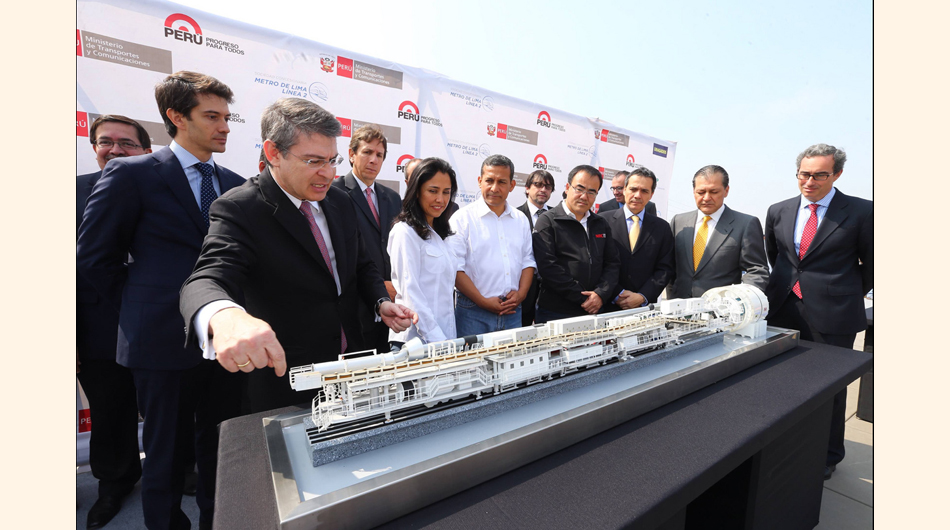The consortium led by ACS and FCC commences the works on Line 2 of the Lima Metro
The most important infrastructure project in the history of Peru needs an investment of 3,619 million euros.

The most important infrastructure project in the history of Peru needs an investment of 3,619 million euros.
The President of Peru, Ollanta Humala, oversaw the commencement of works on Line 2 of the Lima Metro; a project lead by ACS and FCC, and on which other companies such as Impregilo, Cosapi and Ansaldo are collaborating. The event took place on what will be one of the future switchyards of Line 2 of the Lima Metro, a railway station that will serve as the point of assembly and disassembly of trains made up of detached carriages: the Santa Anita works yard.
Also in attendance were the Minister of Transport and Communications, José Gallardo Ku, Chairman of the Concessionaire, Carlos Royo, and the key managers from the Concessionaire's member companies. Miguel Jurado, Chairman of FCC Construcción; Fernando Valdez, General Manager of COSAPI; Ignacio Segura, Chief Executive Officer of Dragados; Juan Santamaría, on behalf of Iridium (ACS); as well as other representatives from the Peruvian corporate sector.
Works on Line 2 of the Lima Metro include construction of 35 km of metro and 35 stations in which 3,619 million euros will be invested and which will be completed in mid-2020. Line 2, which is 26.87 km in length, covers the east-west axis of the city, begins in the district of Ate and finishes at the Port of Callao. A branch of line 4 which will go towards the airport will also be built and will consist of an 8 km long tunnel and 8 new stations, running from Avenida Faucett to Avenida Néstor Gambetta heading northwards. According to current projections, the first phase, between Ate and the Vía de Evitamiento (Santa Anita) will be finished in the second quarter of 2016, and the second phase, between Óvalo Bolognesi (Breña) and the Vía de Evitamiento (Santa Anita), towards the end of 2017.
Carlos Royo, Chairman of the project's Concessionaire, highlighted that the construction process of Line 2 of the Lima Metro will require the use of two tunnelling machines to finish the underground track where the train will circulate. Due to the depth at which it will operate underground of between 10 and 25 metres, its exterior impact with regard to noise, vibrations or emissions, will be kept to a minimum. This modern equipment will not only be used for digging underground, but it will also transport its cuttings to the surface. Additionally, it also lays the reinforced cement blocks which provide stability to the entire structure.
With these tunnelling machines it will be possible to complete 15 metres of work per day and finish in the planned time the 27 kilometres of tunnels of Line 2 of the Lima Metro and the 8 kilometres of the branch of Line 4.
Benefits for the local population
Line 2 of the Lima Metro is the most important traffic project in the history of Peru. Over 3,000 jobs will be created. When it launches, it will transport more than one million passengers a day between the district of Ate, located in the area east of Lima, and the Port of Callao in only 45 minutes, when currently that journey can take two and a half hours. As well as less lime travelling, the system will be safer and more efficient in environmental terms.
Line 2 of the Lima Metro will connect 13 districts with one underground railway line: Ate Vitarte, Santa Anita, San Luis, El Agustino, La Victoria, Breña, Jesús María, Cercado de Lima, San Miguel, La Perla, Bellavista, Carmen de la Legua and Cercado del Callao, benefiting close to 2.4 million inhabitants.
Train access will be completely automated with universal accessibility, escalators, elevators, ticket offices and video surveillance cameras Additionally, it will have 24-hour security and will be accessible for people with physical disabilities.
About the Concessionaire
The Metro de Lima Line 2 Concessionaire comprises businesses including Iridium, FCC, Cosapi, Salini Impregilo, Ansaldo STS and Ansaldo Breda, whose joint net worth is more than 8,533 million euros.
These companies have extensive experience in the design and construction of tunnels, trains and metros worldwide. Between works and concessions they have built more than 3,650 kilometres of tunnels worldwide, 800 kilometres of which have been constructed using the world's most high-technology machinery. They have also designed and constructed the trains and metros in Madrid, Barcelona, Rome, Milan, London, Copenhagen, Toronto, Doha and New York, among others.








